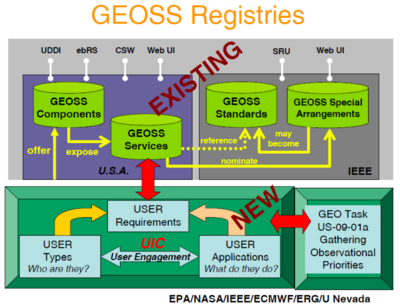User Requirement Registry
From Earth Science Information Partners (ESIP)
< GEO User Requirements for Air Quality | Report | Documents | Resources
Erin: Make Dynamic List for URR Tags
See also GEOSS User Requirements Registry
User Requirements Registry (D. Niebert, 2009)
- Stores requirements by generalized user types that identify observables and their properties (e.g. values, quality, resolution, frequency, units of measure) with respect to a domain of application
- Matching of requirements to service offers can be made in the future as a common vocabulary of observables is developed for GEOSS to:
- Identify coverage and popularity of observations, and
- Identify gaps in coverage of observations
URR Administrative
- UIC recommends the inclusion of a requirements registry for earth observations to be integrated with the existing
services and standards. Requirements available from several members.
- Joint effort and discussion document with UIC is needed to clarify the needs, interaction, governance, and approach of a solution; Could this be achieved through a new Task?
- GEOSS Earth Observation taxonomy or ontology suggested to facilitate association of requirements, services, and applications
- Identify requirements for “observables” ontology drawn from the existing EO communities in order to associate applications, needs, and available services
Tie in with ADC GCI:
- Need to formalize UIC commitment for the operation and interaction with the registry – significant governance issue
- Web-form upload by privileged individuals anticipated
- Batch upload from existing requirements systems also anticipated
- Architectural tie-points exist between the “observations” (observable parameters) and the Services and Standards Registries
- Continued web services and database support to be offered by this Task to UIC during IOC
User Requirements Registry Features (Gary Foley)
- A “user engagement” entry point for the Novice Users coming to the GEO Home Page
- Initially populated from the US-09-01a reports
- Shares info on registered types, applications and requirements; allows users to comment
- Allows users to register their type, applications, and requirements
- A standard vocabulary/ontology for use in registration
- Provides requirements for “Gap Analysis”
User Classes for Air Quality (Gary Foley)
- Public Information Delivery
- Public Emergency & Health Officials
- Operational Modeling Forecasting
- Local & Regional Environmental managers
- Earth Observation Community
Activities of Each User Class
HP Plag:
- SBA-Specific Work Flow Scenarios and Test Cases
Three Test Cases:
- Air Quality and Health: Results of the SBA analysis (sub-SBA Health)
- Geohazards: 2008 Review of Requirements (sub-SBA Disaster)
- GGOS 2020: Cross-cutting (at least seven SBAs)
Activities
- Participate in monthly calls of the Analysts
- Two face-to-face meetings of the Analysts
- Assist with developing concepts and approaches for cross-cutting analyses of the observational priorities and other important information from the 2009 US-09-01a primary reports.
- Conduct further analyses of the area of the Health SBA that would further this cross-cutting effort.
- Engage the AG
- Replace members, as needed.
- Ensure that the AG members have access to the primary and secondary products, as appropriate.
- Database of keywords for the Health SBA area using the 2009 US-09-01a report as the source material for the keywords.
- Populating the User Requirements Registry (URR) and databases with the appropriate information from the primary and secondary products of the 2009 work.
- Conduct an international GEO workshop in the aeroallergens area of the Health SBA jointly with other sponsors to
- engage users
- engage observation providers
- support new Communities of Practice
- present the results of this task
- further populate the URR
- share new GEO-relevant scientific and technical results
- identify voluntary efforts to initiate additional activities, etc.
